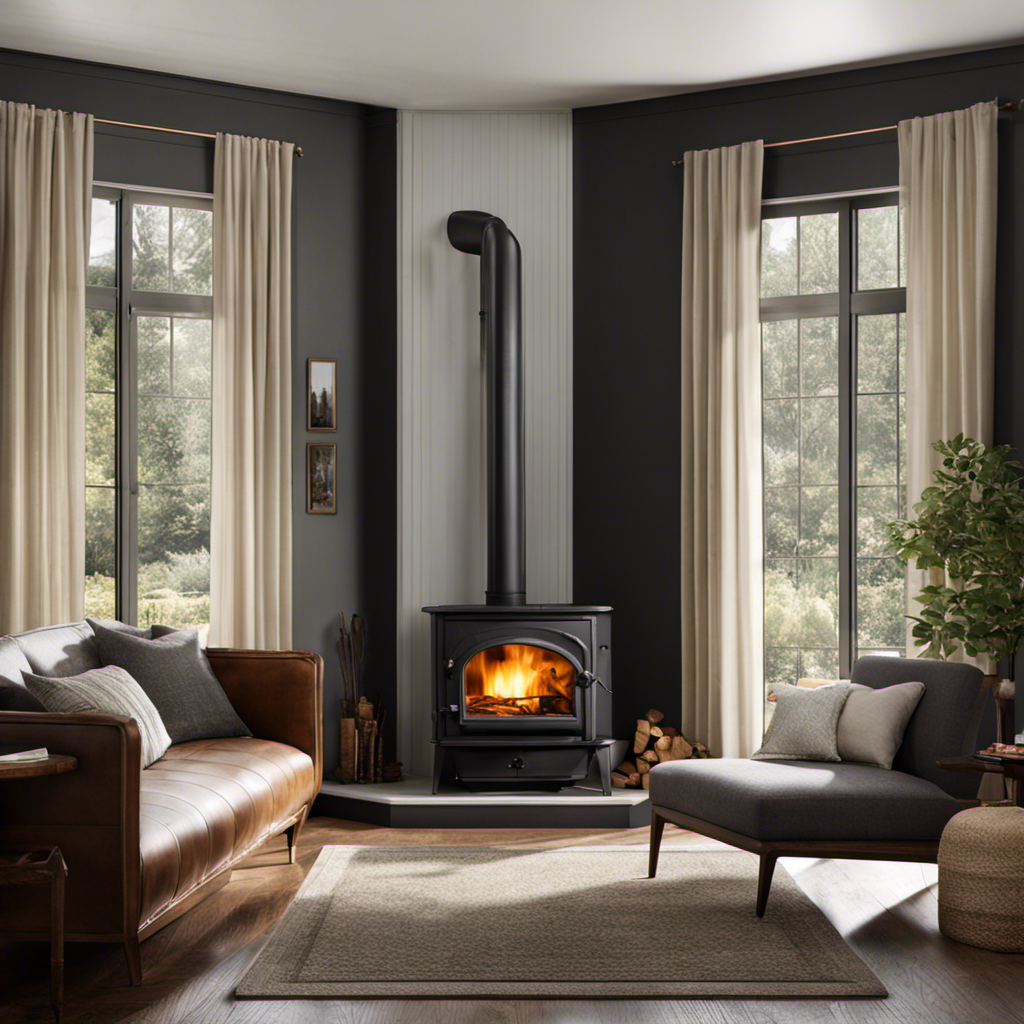I’ve always wanted to install a wood stove in my garage, but I had no idea where to start. That’s when I stumbled upon this comprehensive guide on how to set up a wood stove in a garage.
Trust me, it’s easier than you think. From assessing the space and safety requirements to connecting the stove to the chimney, this article has got you covered.
Get ready to turn your garage into a cozy oasis with the warmth of a wood stove.
Key Takeaways
- Measure the available space and evaluate heating capacity to choose the right wood stove for the garage.
- Check building codes and regulations, and ensure proper ventilation and safety equipment for installation.
- Prepare the garage by assessing airflow, adding insulation, determining safety clearance distances, and installing smoke detectors and carbon monoxide alarms.
- Install a chimney, use a fresh air intake, and ensure proper insulation to retain heat, while regularly testing and maintaining ventilation systems.
Assessing the Space and Safety Requirements
I’ll need to carefully measure the available space and ensure that all safety requirements are met before installing the wood stove in my garage. Assessing the space and safety requirements is crucial to ensure a successful installation and to prevent any potential hazards. Here are the steps to follow:
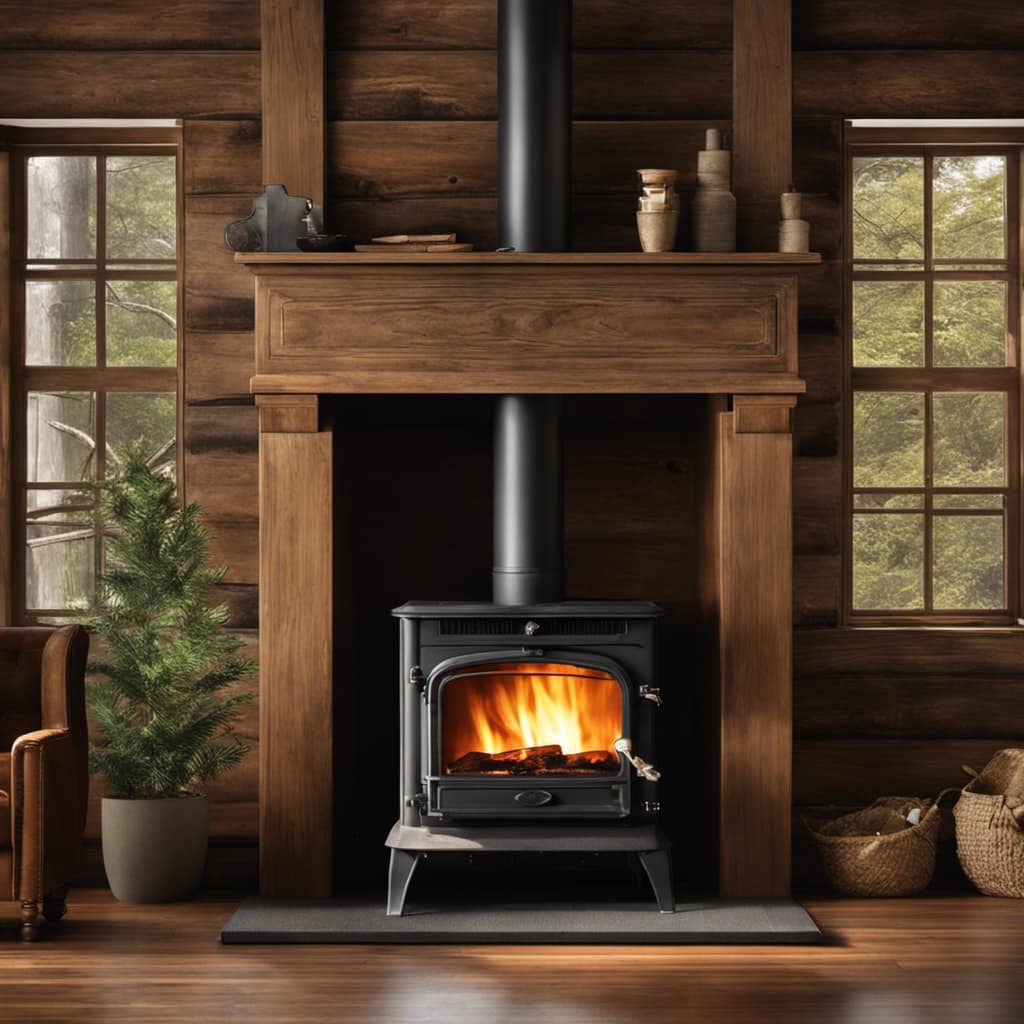
-
Measure the available space: Start by measuring the dimensions of your garage to determine the suitable location for the wood stove. Consider factors such as clearances from walls, ceilings, and combustible materials.
-
Check building codes and regulations: Research the local building codes and regulations regarding wood stove installations in garages. Ensure that you comply with all safety requirements and obtain any necessary permits.
-
Evaluate ventilation options: Proper ventilation is essential for safe operation. Determine if your garage has existing ventilation systems or if you need to install additional vents or chimney systems to ensure proper airflow.
-
Inspect the flooring: Check the condition of the garage floor. It should be made of non-combustible material, such as concrete, to prevent any fire hazards.
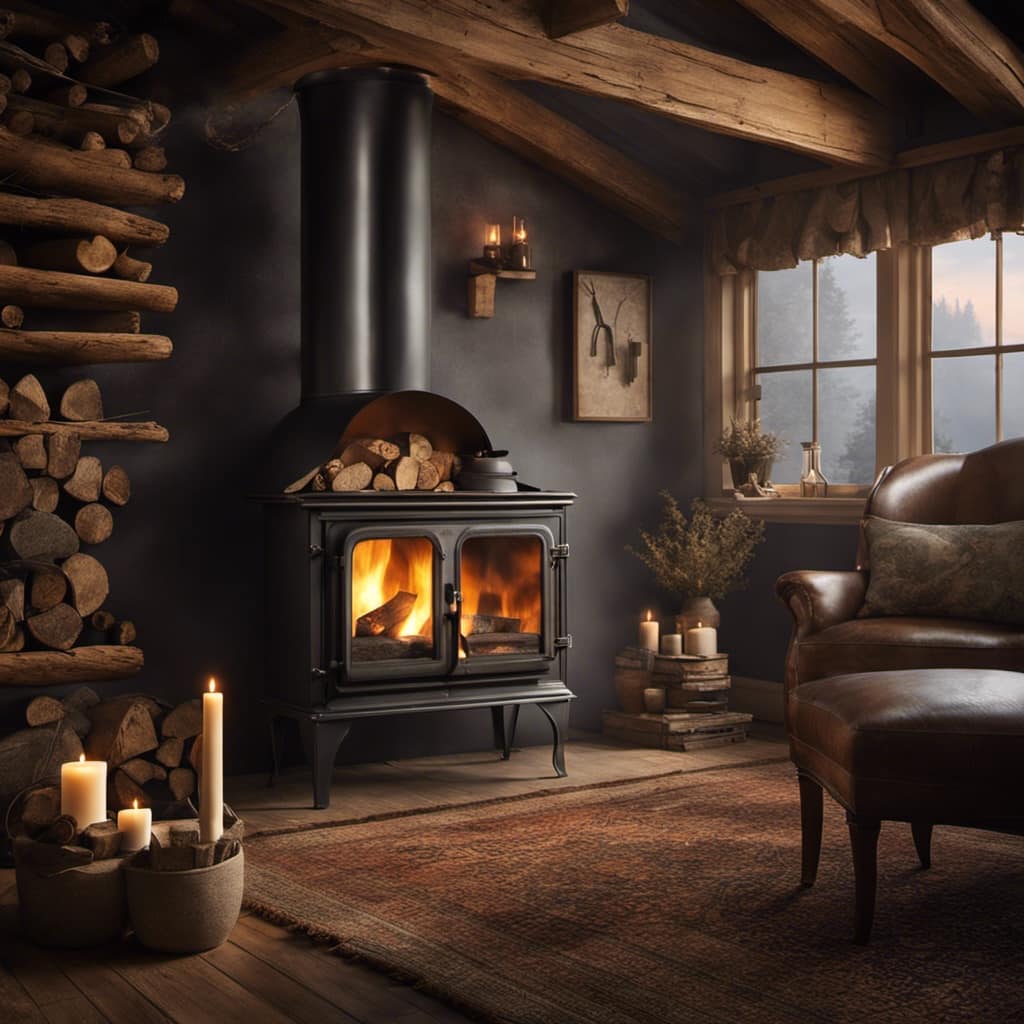
-
Install fireproof barriers: If needed, install fireproof barriers around the wood stove to protect nearby combustible materials. This can include heat shields or non-combustible walls.
Choosing the Right Wood Stove for Your Garage
When selecting the best option, it’s important to consider the size and heating capacity of the stove that will suit my garage. Assessing the size and capacity of the wood stove is crucial to ensure efficient heating and avoid any safety issues.
Here are the steps to choosing the right wood stove for your garage:
-
Measure the garage space: Determine the size of your garage to find a wood stove that fits comfortably without overcrowding the area.
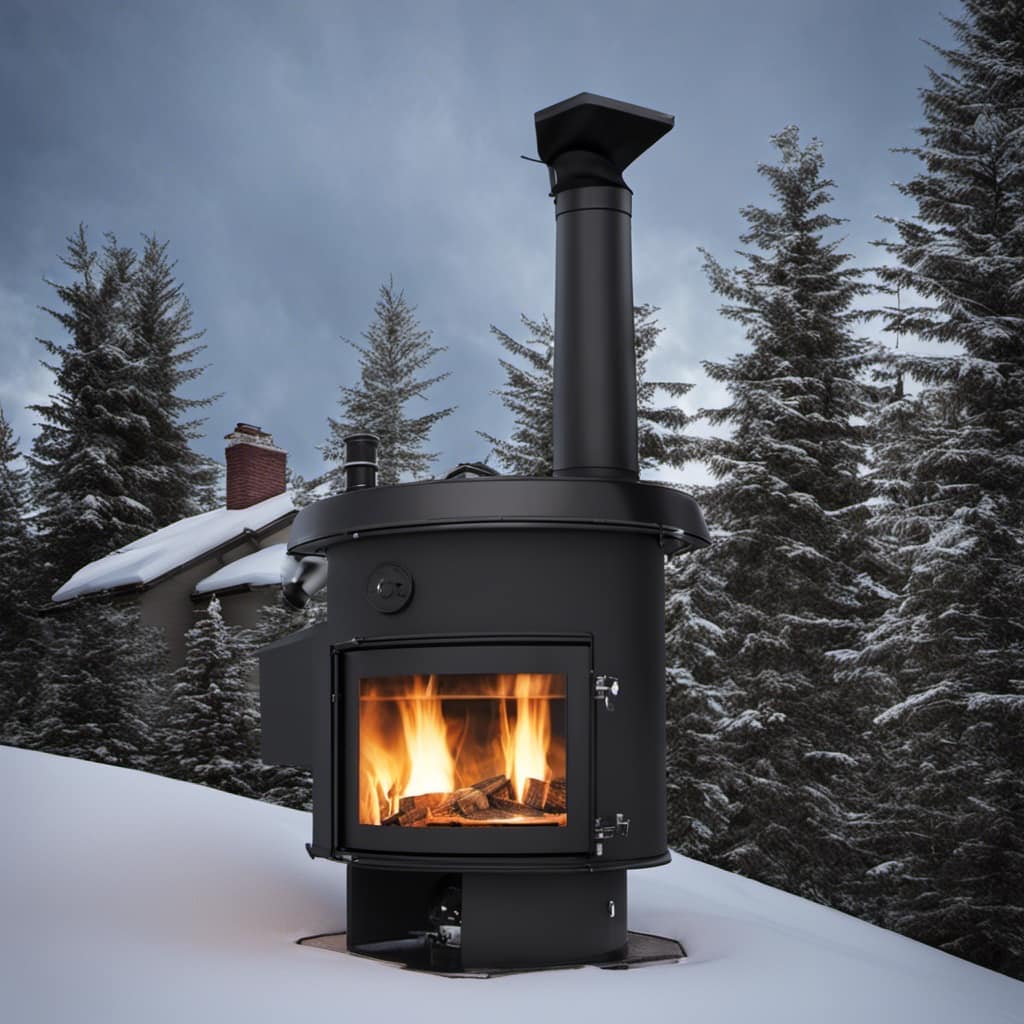
-
Evaluate heating capacity: Consider the square footage of your garage and the insulation level to determine the BTU (British Thermal Unit) output required. This will ensure that the wood stove can adequately heat the space.
-
Evaluate the fuel options: Wood stoves can burn a variety of fuels, including firewood, pellets, or coal. Evaluate the availability and cost of these fuel options in your area to choose the most practical and cost-effective option for your needs.
Gathering the Necessary Tools and Materials
To complete the project, I’ll need a measuring tape, screwdriver, and the appropriate fuel source for the wood stove.
Before starting the installation process, it’s important to assess the safety of the area where the wood stove will be placed. Make sure the garage has proper ventilation and is equipped with a smoke detector and carbon monoxide alarm.

It’s also crucial to choose the right materials for the installation. Opt for a wood stove that’s specifically designed for garage use and meets all safety requirements. Additionally, select a chimney pipe that’s compatible with the stove and suitable for your garage’s layout. The pipe should be made of durable materials, such as stainless steel, to withstand high temperatures and provide proper ventilation.
Don’t forget to purchase the necessary insulation and fireproof materials to ensure the wood stove is installed safely.
Preparing the Garage for Wood Stove Installation
To prepare the garage for wood stove installation, I first need to ensure proper ventilation for safety. This involves assessing the existing airflow in the space and making any necessary modifications, such as installing vents or fans.
Next, I’ll focus on insulation to retain heat efficiently. This may include adding insulation to the walls and ceiling to create a more cozy and comfortable environment.
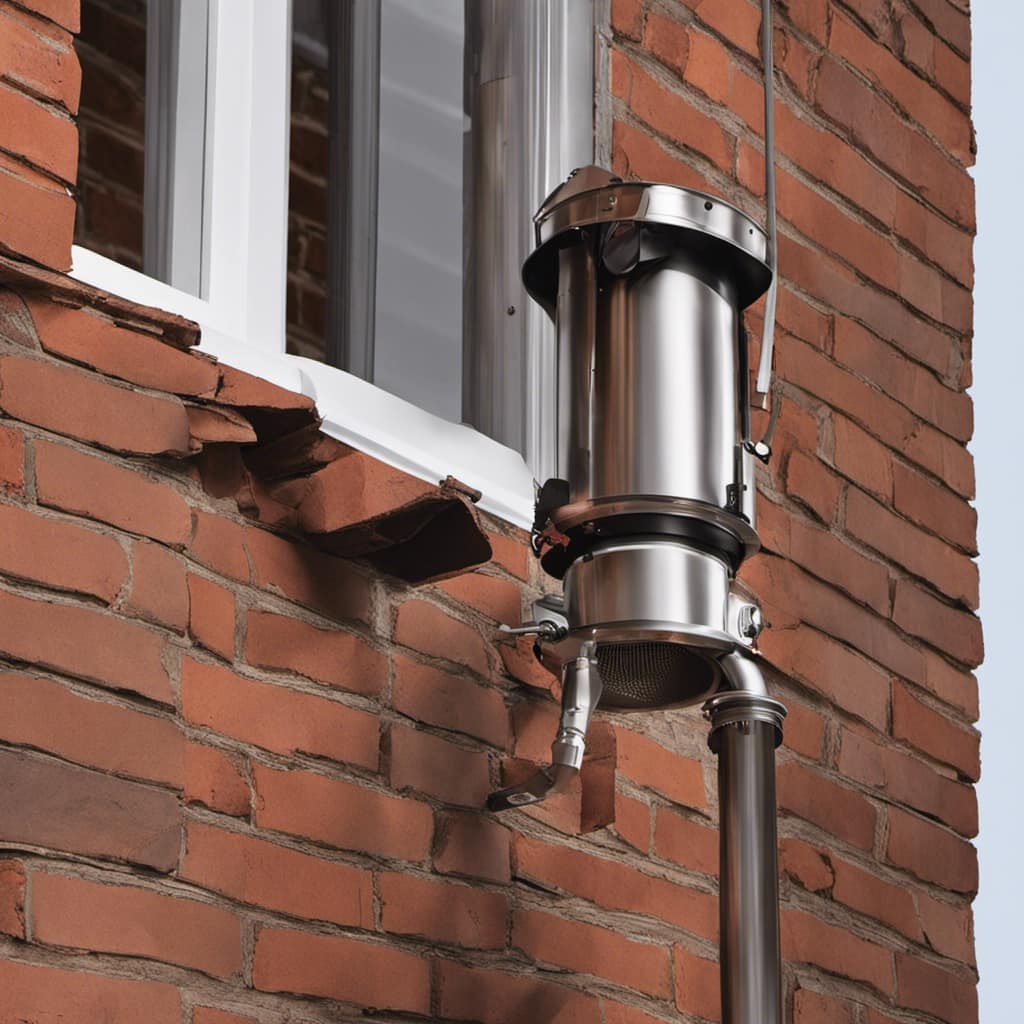
Lastly, I must consider clearance distances to maintain safety. This involves determining the required space between the stove and any combustible materials, as well as ensuring there’s enough room for easy access and maintenance.
Ventilation Requirements for Safety
I need to ensure that proper ventilation is in place to meet safety requirements for installing a wood stove in my garage. Ventilation is crucial for the safe operation of a wood stove, as it helps remove harmful gases and prevents the buildup of carbon monoxide.
Here are three ventilation techniques and safety precautions to consider:
-
Install a chimney: A chimney directs the smoke and gases produced by the wood stove out of the garage. It should be properly insulated and extend above the roofline to prevent backdraft and ensure effective ventilation.
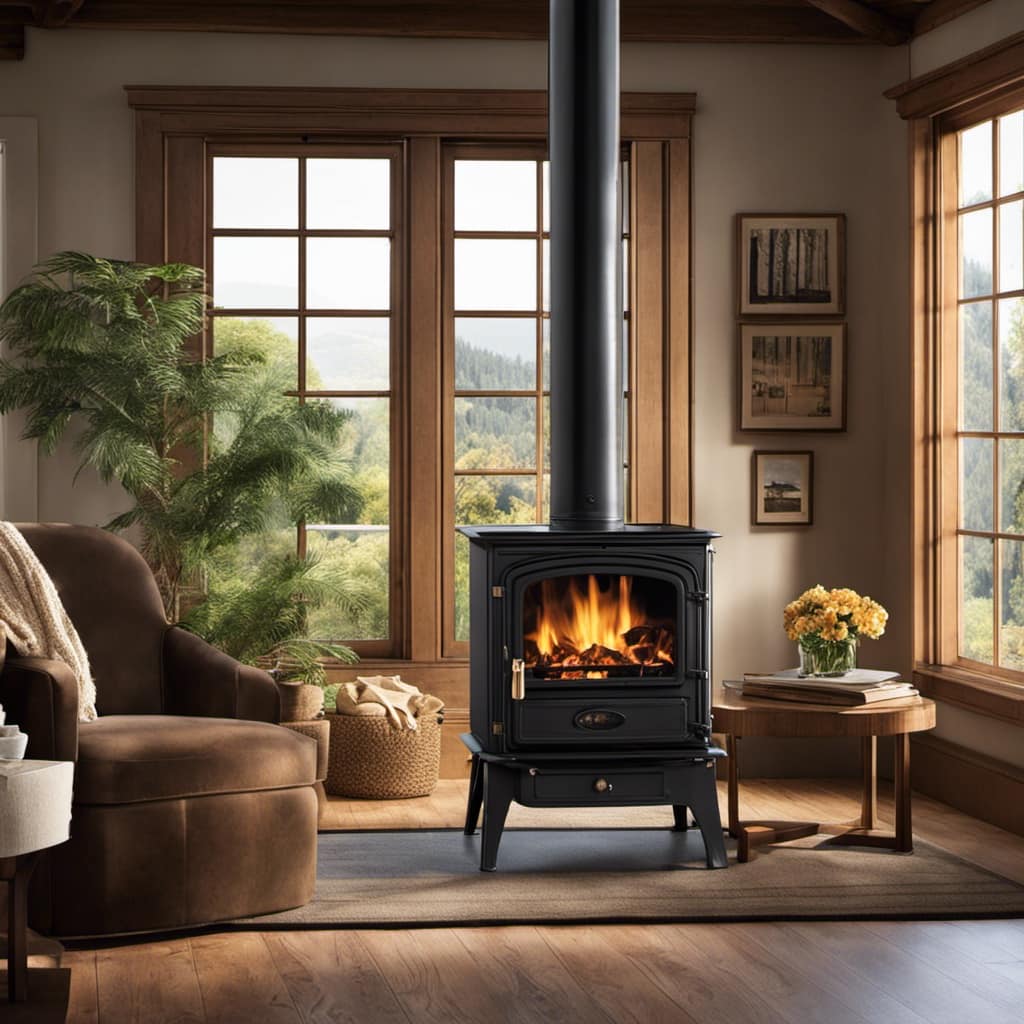
-
Use a fresh air intake: A fresh air intake provides a steady supply of oxygen for combustion. It should be installed near the wood stove to prevent air starvation and maintain proper ventilation.
-
Install carbon monoxide detectors: Carbon monoxide is a silent killer, so it’s important to have detectors in the garage. Place them near the wood stove and ensure they’re regularly tested and maintained.
Insulation for Heat Retention
Now that we have discussed the ventilation requirements for safety when installing a wood stove in a garage, let’s move on to the next important aspect: insulation for heat retention. Proper insulation is crucial to ensure that the heat generated by the wood stove stays inside the garage, providing warmth and comfort. Insulation offers several benefits, including increased energy efficiency and reduced heat loss. There are various insulation materials available in the market, such as fiberglass, cellulose, and foam board. Each material has its own advantages and considerations. To help you make an informed decision, I have created a table below comparing the key features of these insulation materials:
| Insulation Material | Benefits | Considerations |
|---|---|---|
| Fiberglass | – Good thermal resistance |
- Easy to install | – Can cause skin irritation
- Prone to moisture damage |
| Cellulose | – Excellent thermal performance - Environmentally friendly | – Requires professional installation
- Can settle over time |
| Foam Board | – High insulation value - Resistant to moisture and pests | – More expensive than other options
- Difficult to install in existing walls |
Now that we understand the benefits and considerations of different insulation materials, we can move on to discussing the clearance distances for safety when installing a wood stove in a garage.
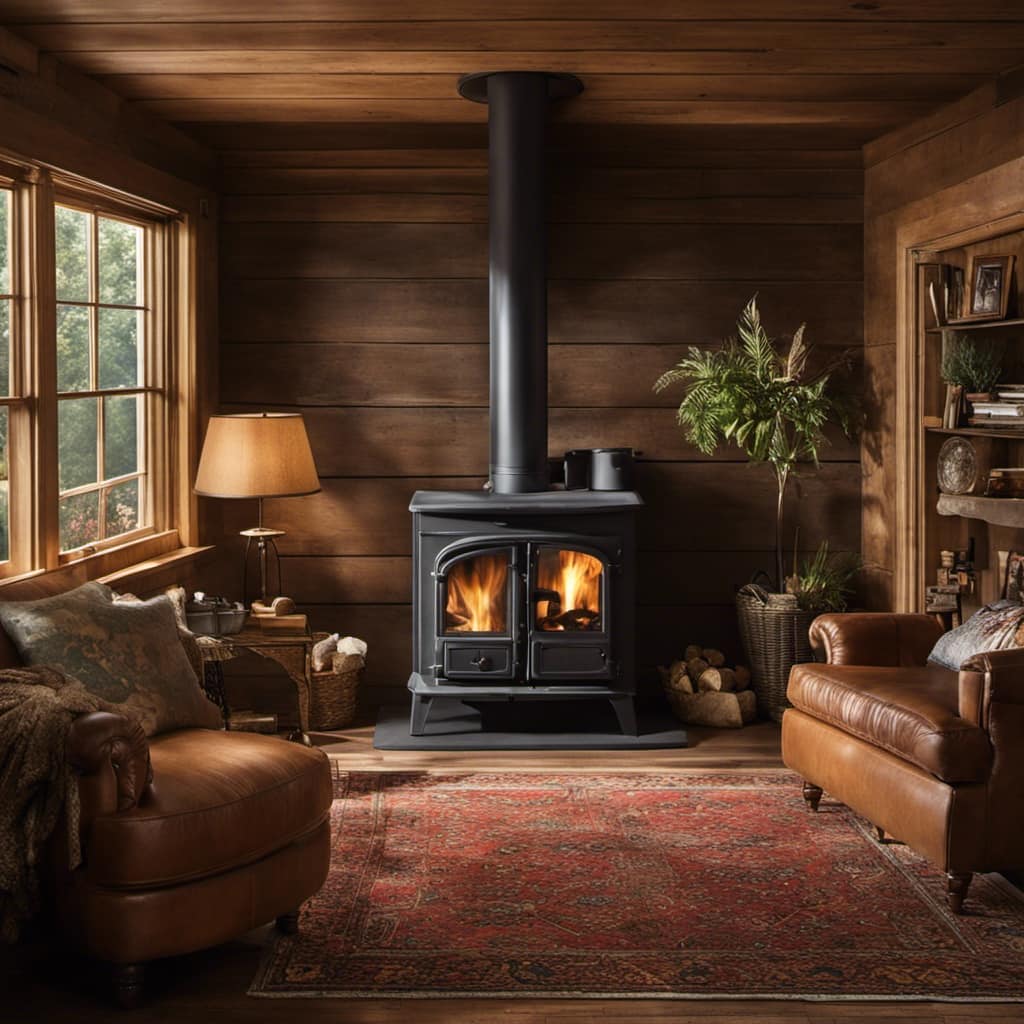
Clearance Distances for Safety
When considering safety, it’s important to be aware of the required clearance distances for a wood stove installation. Adhering to these clearance requirements is crucial to ensure the safety of your home and prevent any potential fire hazards. Here are the key safety precautions to keep in mind:
-
Maintain a minimum clearance of 36 inches between the wood stove and any combustible materials such as walls, furniture, or curtains.
-
Install a non-combustible floor protection with a minimum size of 18 inches in front of the wood stove.
-
Provide proper clearance to the ceiling by ensuring a minimum distance of 36 inches between the top of the wood stove and any combustible materials.
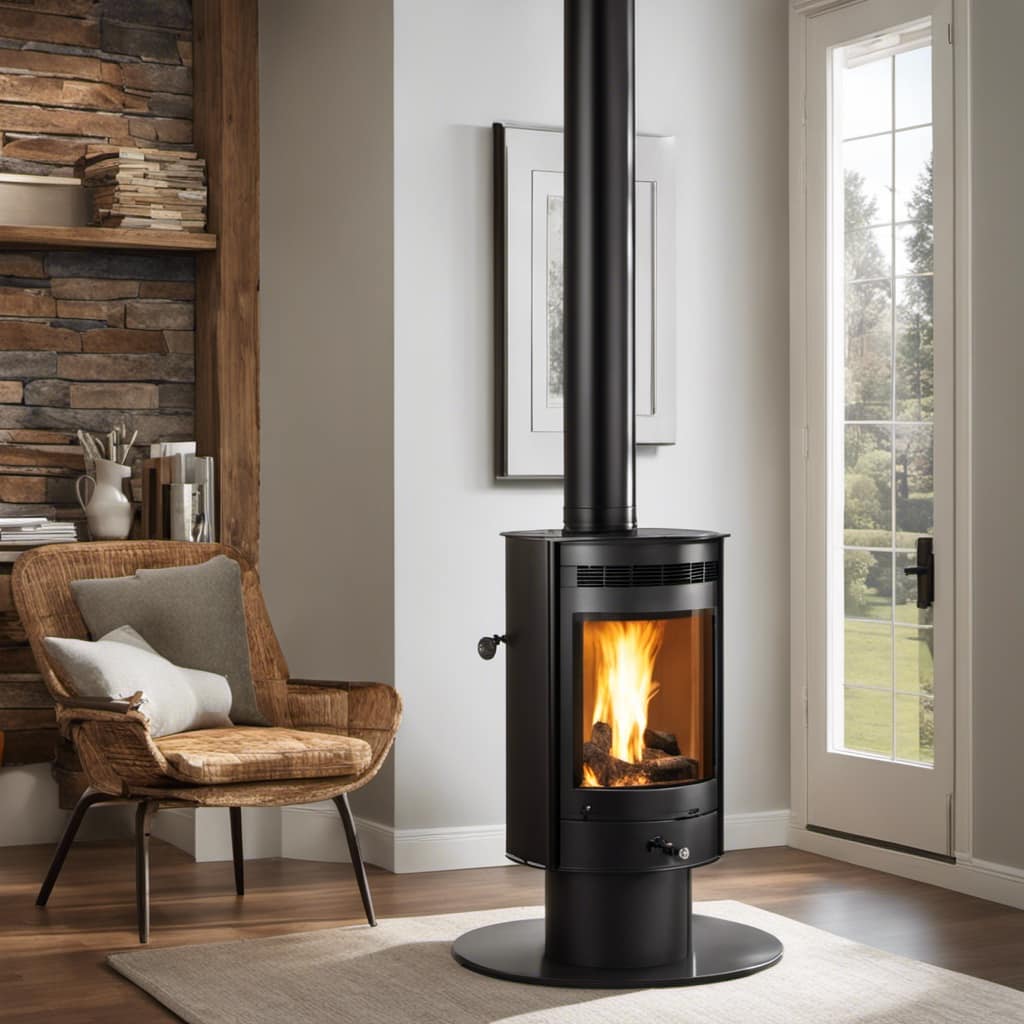
By following these clearance requirements, you can significantly reduce the risk of fire and ensure the safe operation of your wood stove.
Now, let’s move on to the next step of installing the chimney or venting system.
Installing the Chimney or Venting System
To install the chimney or venting system, follow these steps:
-
Determine the proper location for the chimney. Ensure that it is away from any combustible materials.
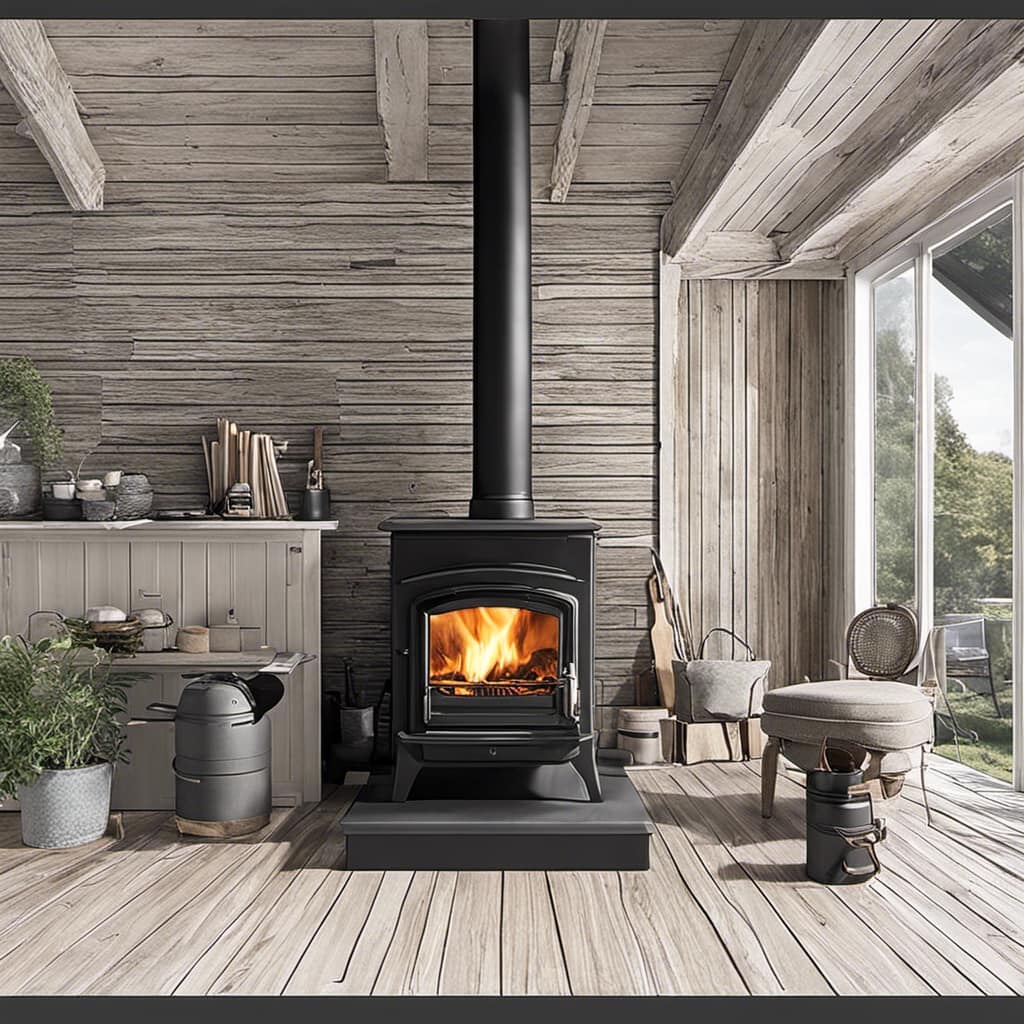
-
Assemble the chimney components according to the manufacturer’s instructions. Make sure to securely connect each section.
-
Attach the chimney to the wood stove. Ensure a tight seal to prevent any leaks.
-
Extend the chimney through the roof or sidewall. Follow the specific venting requirements for your wood stove model.
Remember to consult the manufacturer’s instructions for any specific guidelines or recommendations related to your particular wood stove model.
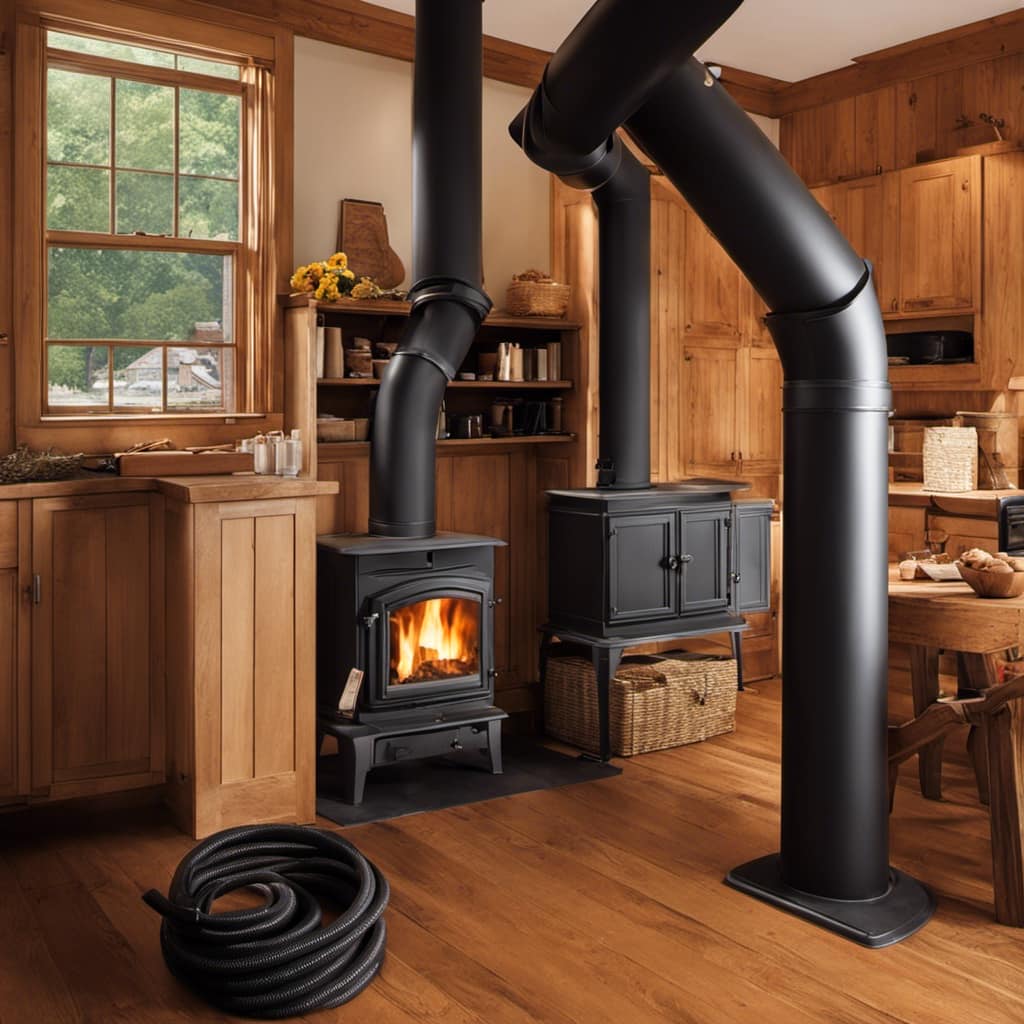
Proper Chimney Installation
I’ll make sure to properly install the chimney for my wood stove in the garage. Here are the steps to ensure a successful installation:
-
Choose the right location: Select a spot in the garage where the chimney can be easily installed and will provide efficient heat distribution.
-
Measure and plan: Determine the appropriate height for the chimney, ensuring it extends at least 3 feet above the highest point of the roof. Plan the route the chimney will take through the garage and roof.
-
Install the chimney components: Assemble the chimney sections, starting from the wood stove and working upwards. Attach the necessary supports and secure the chimney in place.
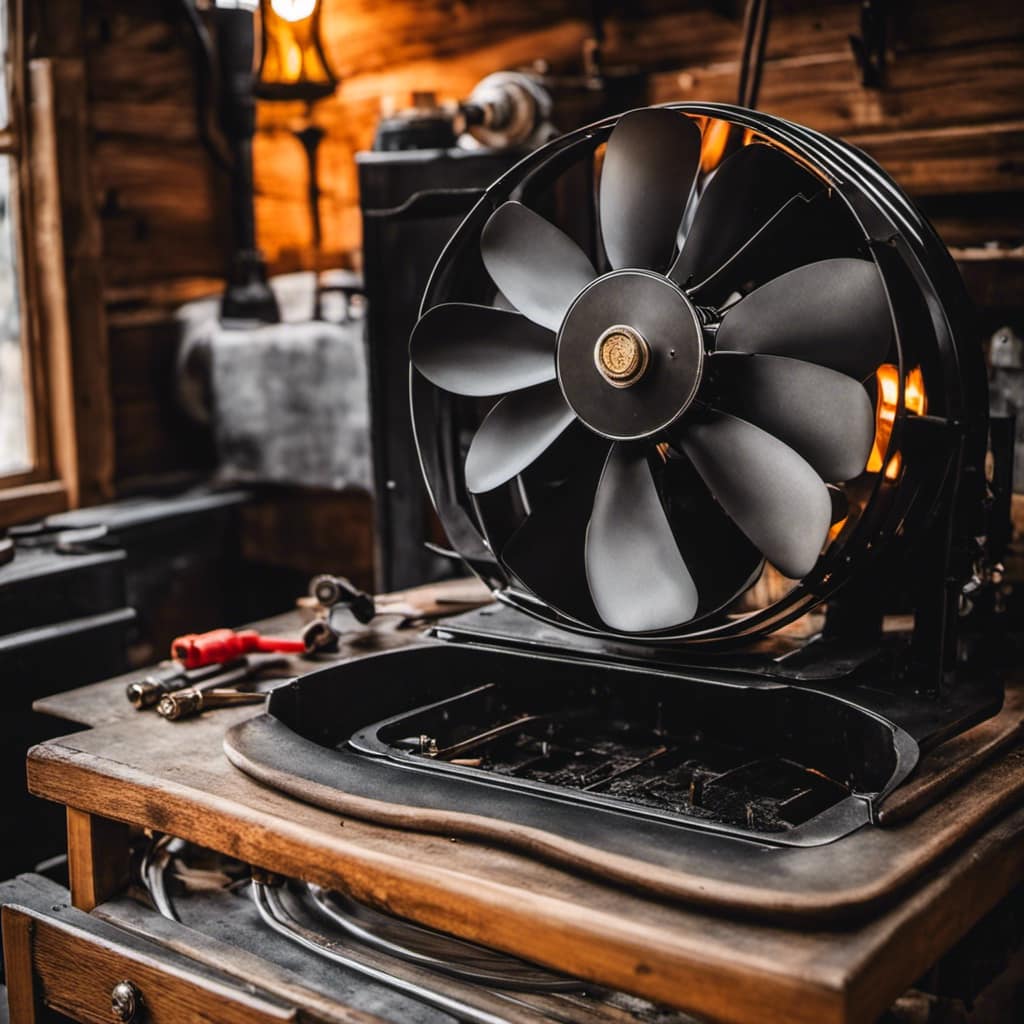
Proper chimney installation is crucial for the safe and efficient operation of your wood stove.
Once the chimney is installed, you can move on to the next step of the process, which involves meeting the venting system requirements.
Venting System Requirements
For efficient operation of my wood stove, it’s important to meet the venting system requirements.
The venting system design plays a crucial role in ensuring the proper functioning of the wood stove and maintaining indoor air quality.
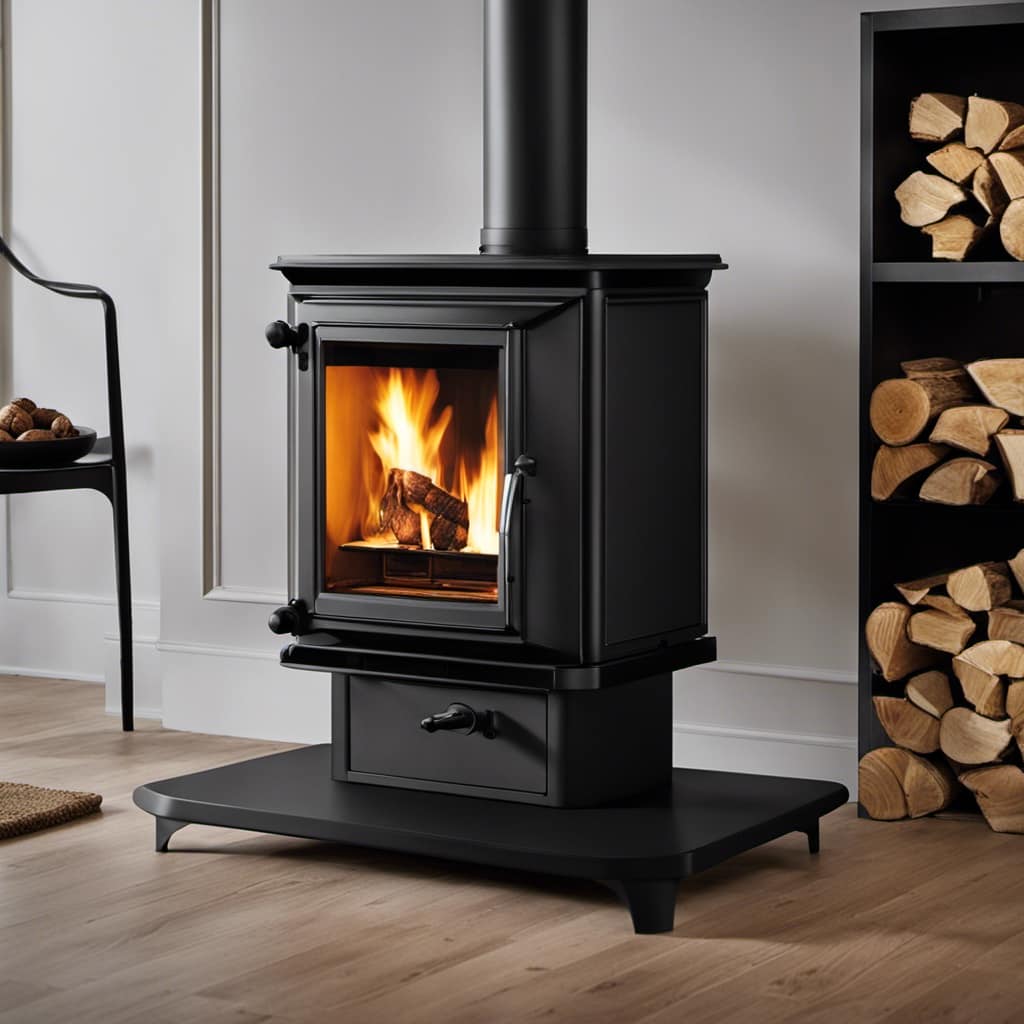
To start with, I need to determine the appropriate size and type of venting system based on the stove’s specifications and the layout of my garage.
Next, I must ensure that the venting system installation complies with local building codes and regulations.
This includes properly installing the chimney, stovepipe, and any necessary connectors or adapters.
It’s essential to follow the manufacturer’s instructions and guidelines for safe and efficient venting.
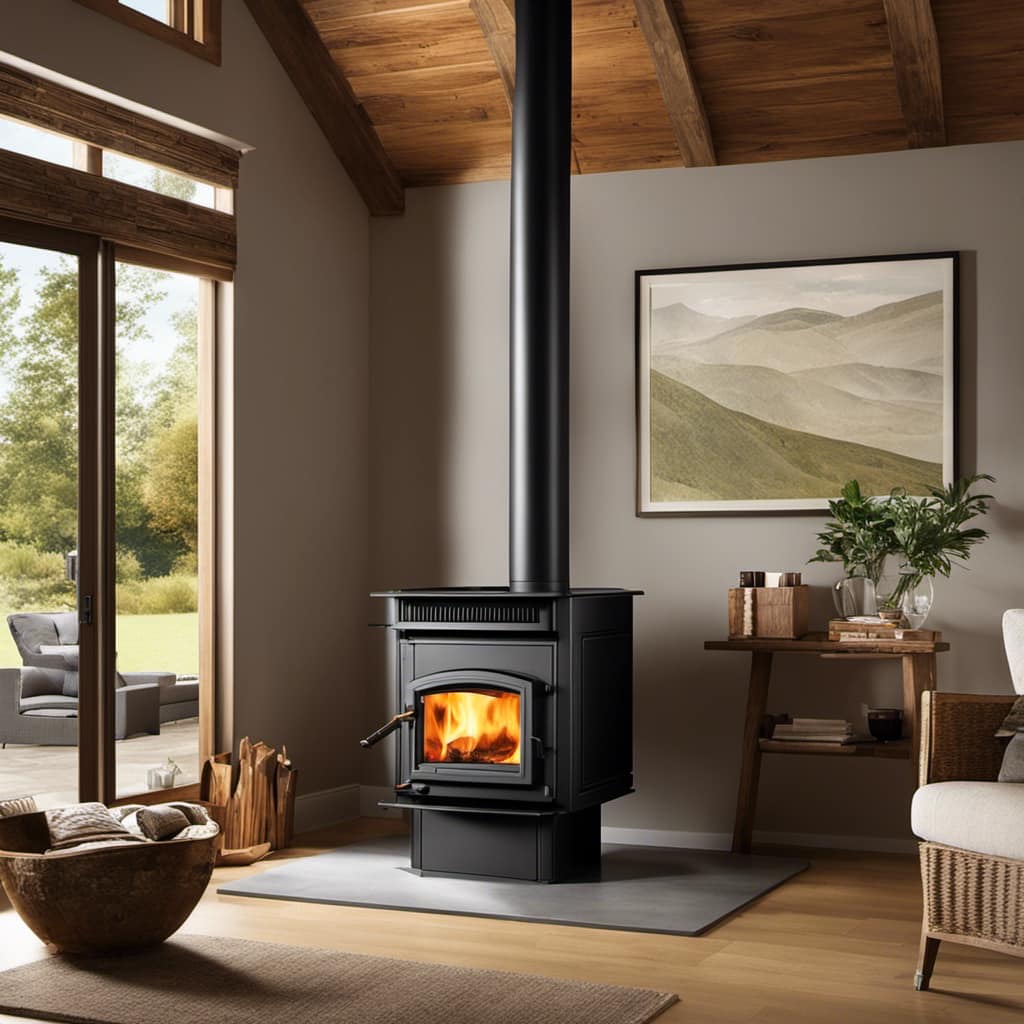
Regular maintenance and inspections are also important to ensure the venting system remains in good working condition.
Positioning and Securing the Wood Stove in the Garage
I’m going to make sure the wood stove is positioned securely in the garage. Proper positioning is crucial for the safe and efficient operation of your wood stove. Here are some positioning tips and securing methods to follow:
-
Location: Choose a spot in your garage that’s away from flammable materials, such as gasoline, paint, or cleaning supplies. Ensure that there’s enough clearance around the stove for proper ventilation and maintenance.
-
Clearance: Maintain the required clearance distances specified by the manufacturer. This includes the distance from combustible walls, ceilings, and other objects. Refer to the stove’s installation manual for specific clearance requirements.
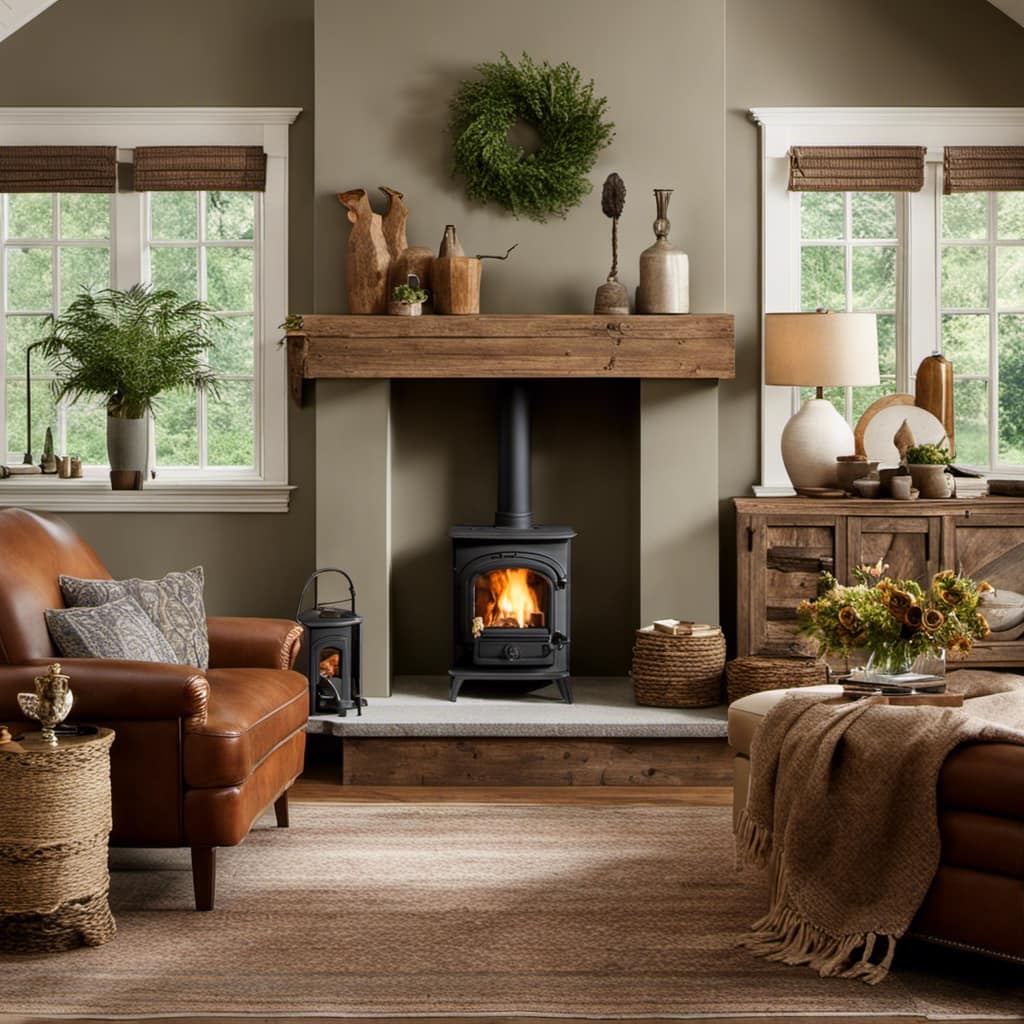
-
Floor Protection: Install a non-combustible hearth pad or floor protection material beneath the stove to protect the floor from heat and sparks. This can be made of materials like tile, brick, or sheet metal.
Securing the stove:
-
Use stovepipe brackets or wall straps to secure the stovepipe to the wall or ceiling. This prevents accidental movement or dislodging of the stovepipe.
-
Install a heat shield on the wall behind the stove to protect the wall from excessive heat. The heat shield should be made of non-combustible material and provide sufficient clearance.
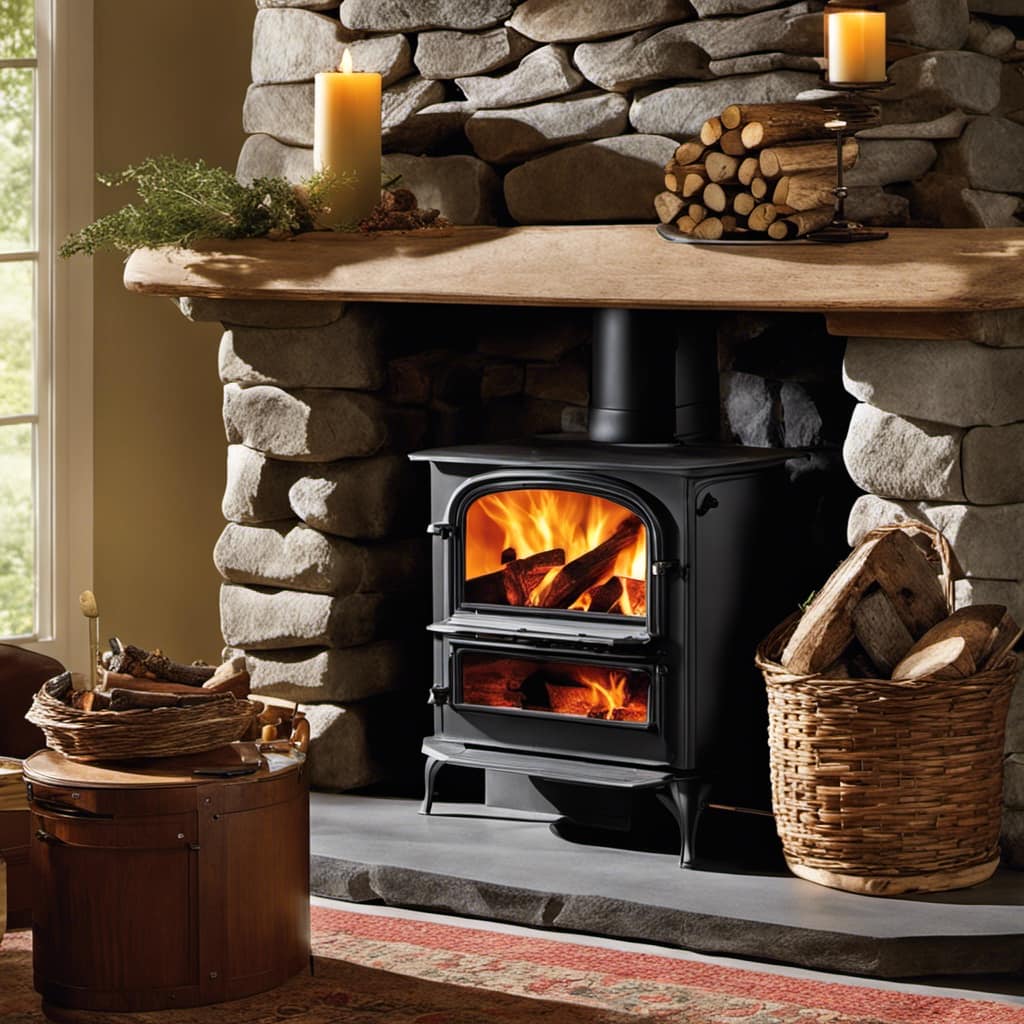
-
Consider using anchor bolts or brackets to secure the stove to the floor or wall. This adds an extra level of stability and prevents the stove from tipping over.
Connecting the Stove to the Chimney or Venting System
Connecting the stove to the chimney or venting system is an important step in ensuring proper ventilation and safe operation of the heating appliance. When installing a wood stove in a garage, it is crucial to connect it to the existing chimney or install a venting system specifically designed for wood stoves. Here is a step-by-step guide on how to connect your stove to the chimney or venting system:
-
Determine the type and size of the chimney or venting system needed for your wood stove. Consult local building codes and regulations to ensure compliance.
-
Measure the distance between the stove and the chimney or venting system. This will determine the length of the stovepipe or vent pipe needed.

-
Install the stovepipe or vent pipe from the stove to the chimney or venting system. Use the appropriate connectors and secure them tightly to prevent any leaks.
-
Insulate the stovepipe or vent pipe to reduce heat loss and improve efficiency. Use high-temperature insulation materials specifically designed for wood stoves.
-
Test the connection for any leaks or loose fittings. Light a small fire in the stove and check for any smoke escaping from the connections.
By following these steps, you can ensure that your wood stove is properly connected to the chimney or venting system, providing efficient heating and safe operation in your garage.
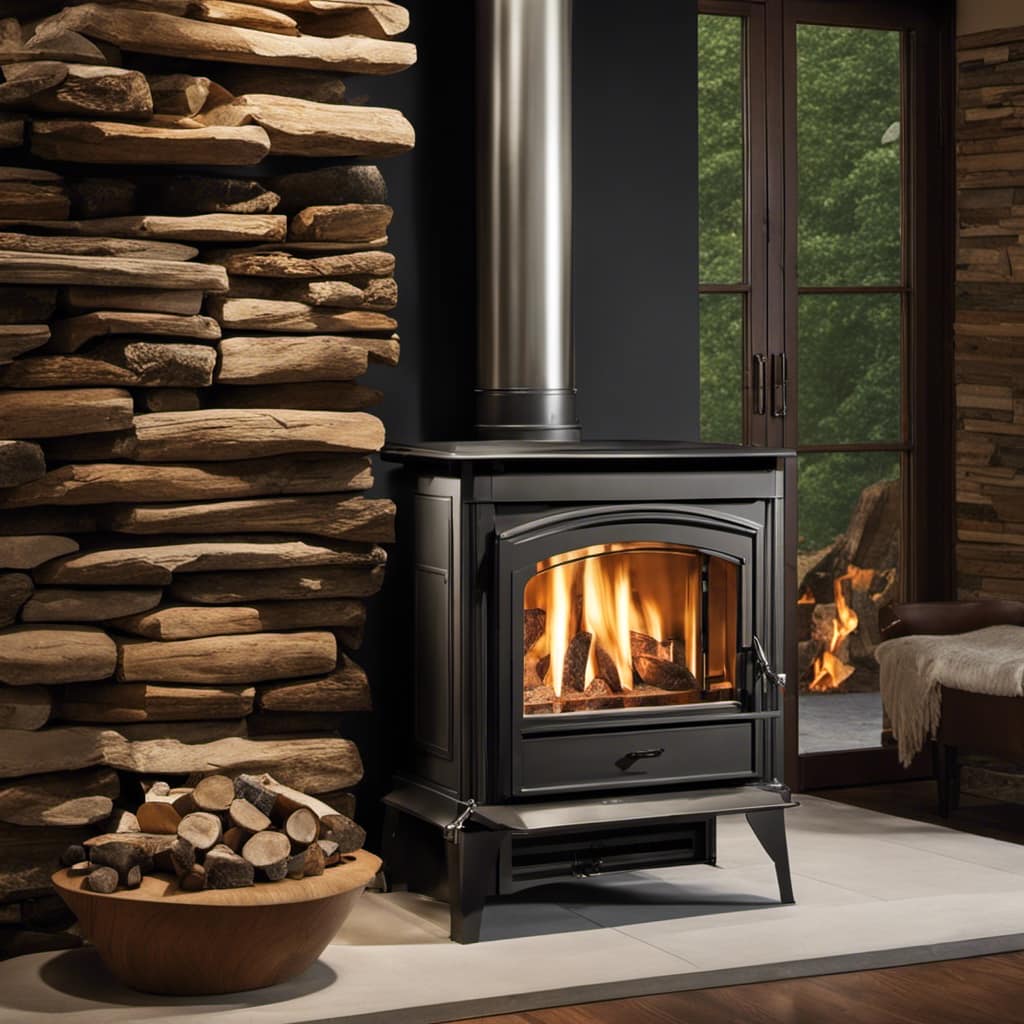
| Steps | Description |
|---|---|
| 1 | Determine the type and size of the chimney or venting system needed |
| 2 | Measure the distance between the stove and the chimney or venting system |
| 3 | Install the stovepipe or vent pipe |
| 4 | Insulate the stovepipe or vent pipe |
| 5 | Test the connection for any leaks or loose fittings |
Testing the Wood Stove and Ensuring Proper Ventilation
During the testing process, I check for any signs of smoke escaping from the connections to ensure proper ventilation. Proper ventilation is crucial when installing a wood stove in a garage to prevent the buildup of harmful gases and ensure optimal performance.
Here are some testing procedures and troubleshooting techniques to follow:
-
Inspect the connections: Carefully examine the stovepipes and chimney connections for any gaps, leaks, or loose fittings. Use a flashlight to look for smoke escaping while the stove is in use.
-
Conduct a smoke test: To perform a smoke test, light a small fire in the wood stove and observe the smoke behavior. It should flow up the chimney or venting system without any visible leaks or backdrafts.
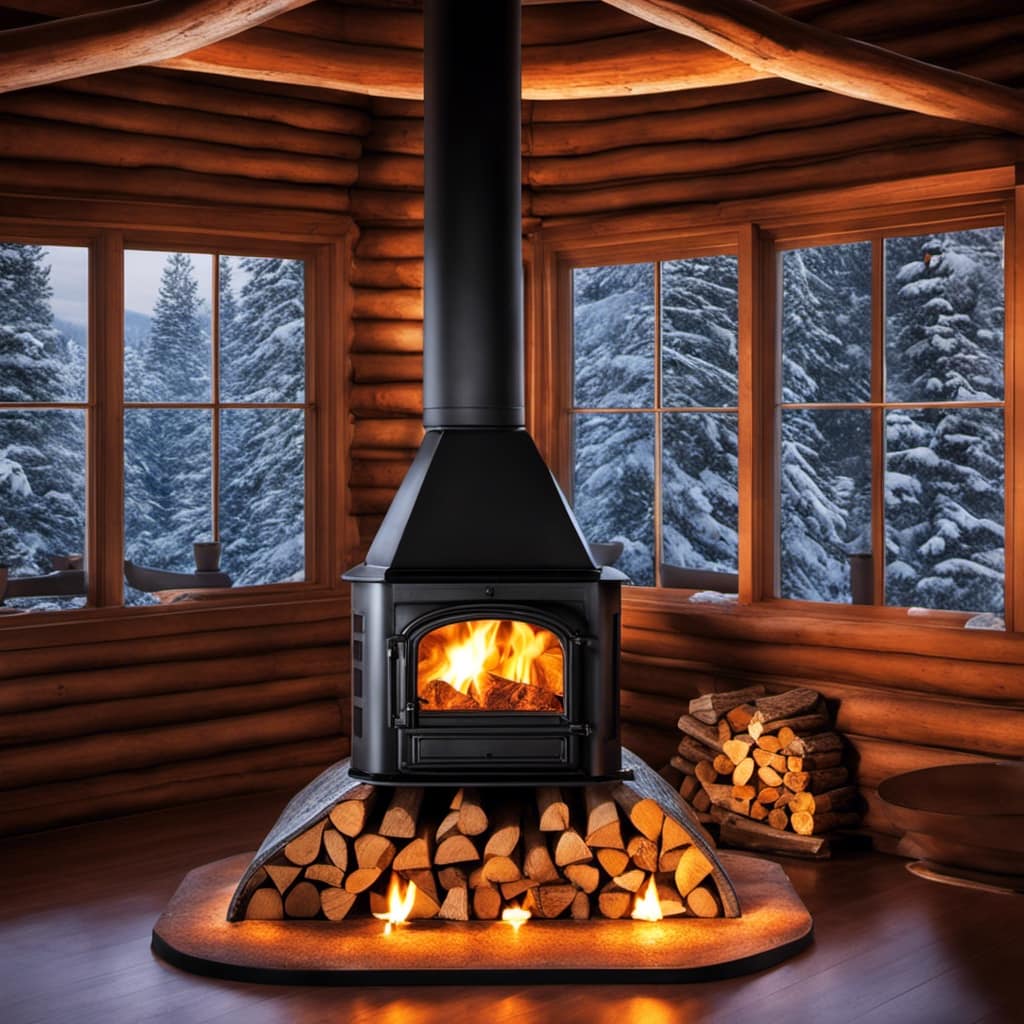
-
Check for draft issues: If you notice smoke escaping from the connections or experiencing a weak draft, troubleshoot by adjusting the damper, cleaning the chimney, or ensuring proper air intake.
Maintaining and Cleaning Your Wood Stove for Longevity
To ensure the longevity of my wood stove, regular maintenance and cleaning are essential. By following these cleaning techniques and maintenance tips, I can keep my wood stove in great condition for years to come.
-
Start by allowing the stove to cool down completely before beginning any cleaning or maintenance. This will prevent any accidents or injuries.
-
Remove any ashes and debris from the firebox using a metal scoop or shovel. Dispose of the ashes in a metal container and store it outside, away from any flammable materials.
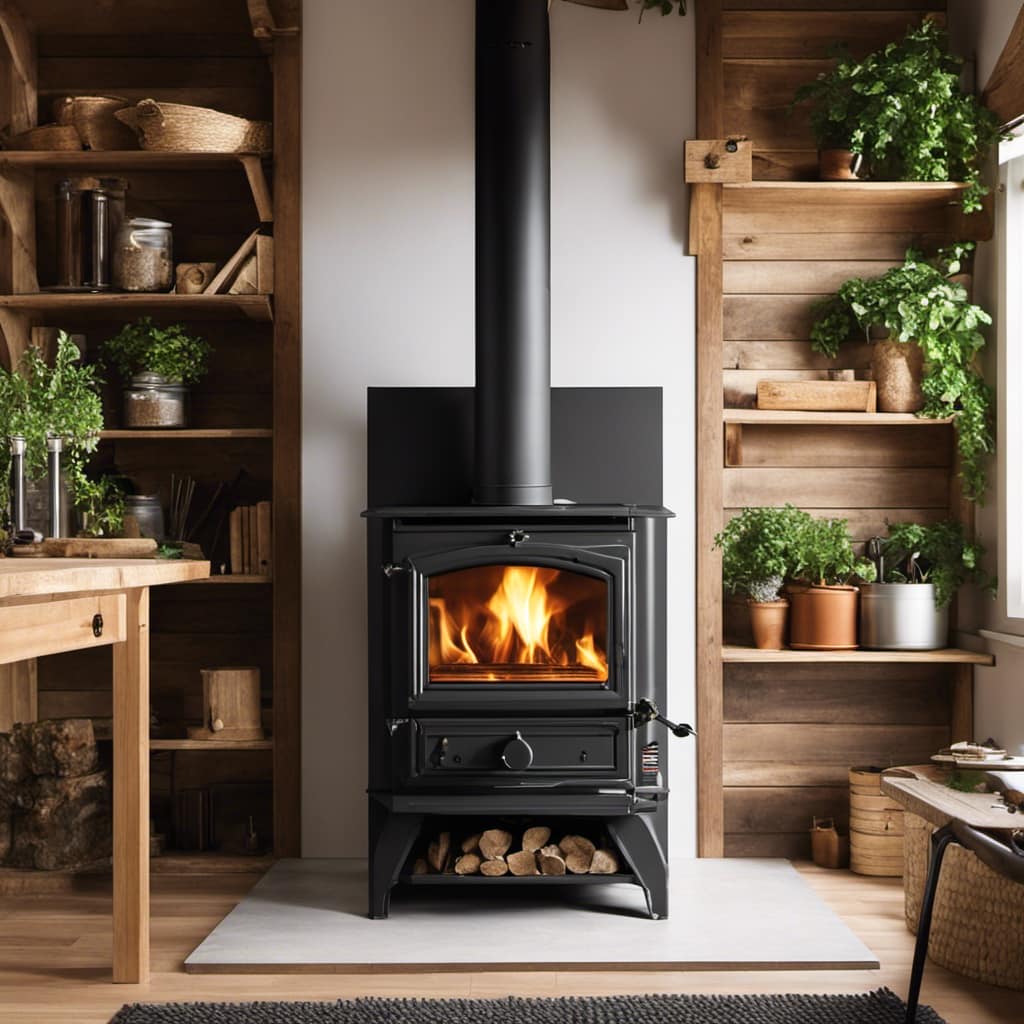
-
Use a wire brush to clean the inside of the firebox and remove any built-up creosote. Creosote is a byproduct of burning wood and can lead to chimney fires if not removed regularly.
-
Inspect the door gasket for any signs of wear and tear. Replace it if necessary to ensure a tight seal and prevent any air leaks.
-
Clean the glass door using a non-abrasive glass cleaner. Be sure to follow the manufacturer’s instructions for cleaning to avoid damaging the glass.
-
Finally, check the chimney and flue for any blockages or debris. Use a chimney brush to remove any creosote buildup and ensure proper ventilation.
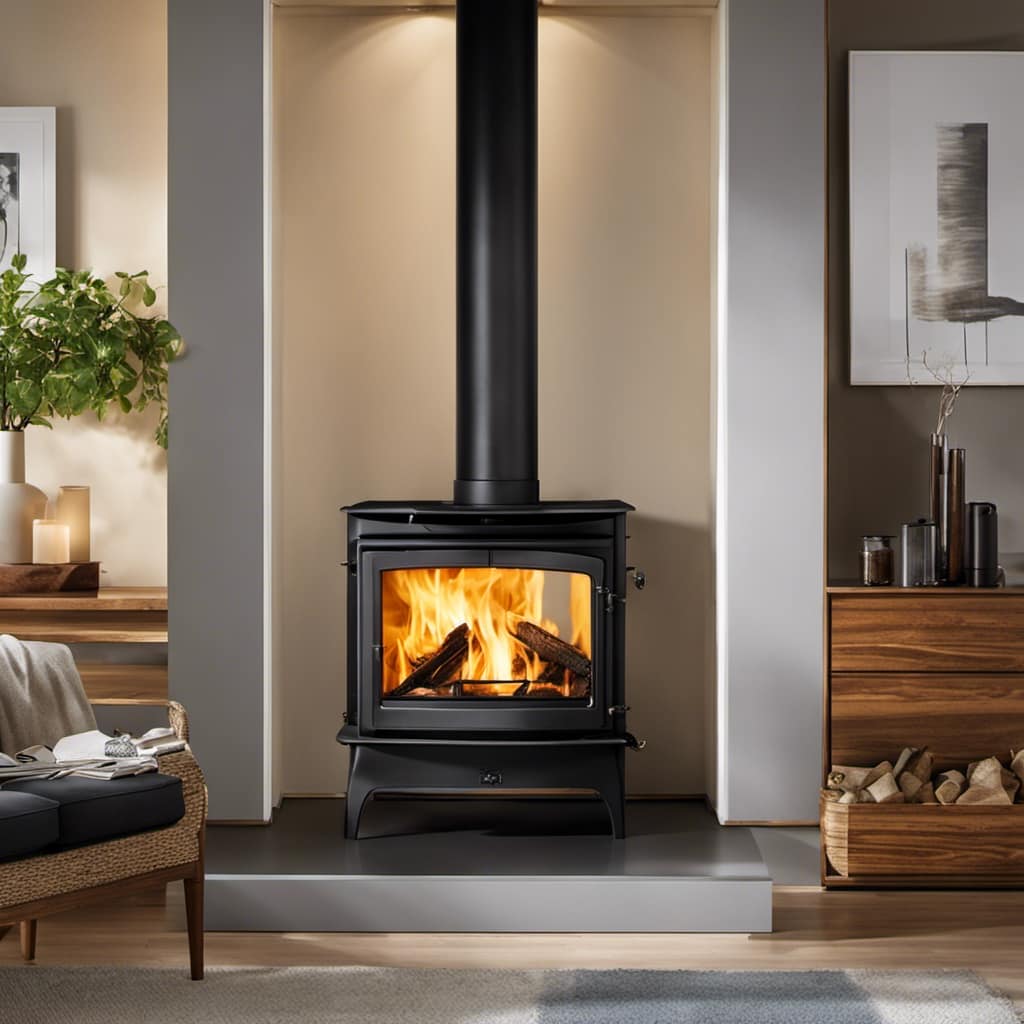
Frequently Asked Questions
Can I Install a Wood Stove in My Garage if I Have Limited Space?
Yes, you can install a wood stove in your garage even if you’ve limited space. When considering the best location for installing a wood stove, it’s important to ensure proper clearances from combustible materials.
Additionally, you’ll need to provide adequate ventilation to prevent the buildup of harmful gases. It’s recommended to consult a professional to determine the specific requirements and guidelines for installing a wood stove in your garage.
Are There Any Specific Safety Requirements I Should Be Aware of When Installing a Wood Stove in a Garage?
When it comes to installing a wood stove in a garage, safety is paramount. There are specific safety requirements that you should be aware of to ensure a secure installation.
Precautions must be taken to protect against fire hazards and carbon monoxide poisoning. Proper ventilation, clearances, and insulation are essential.
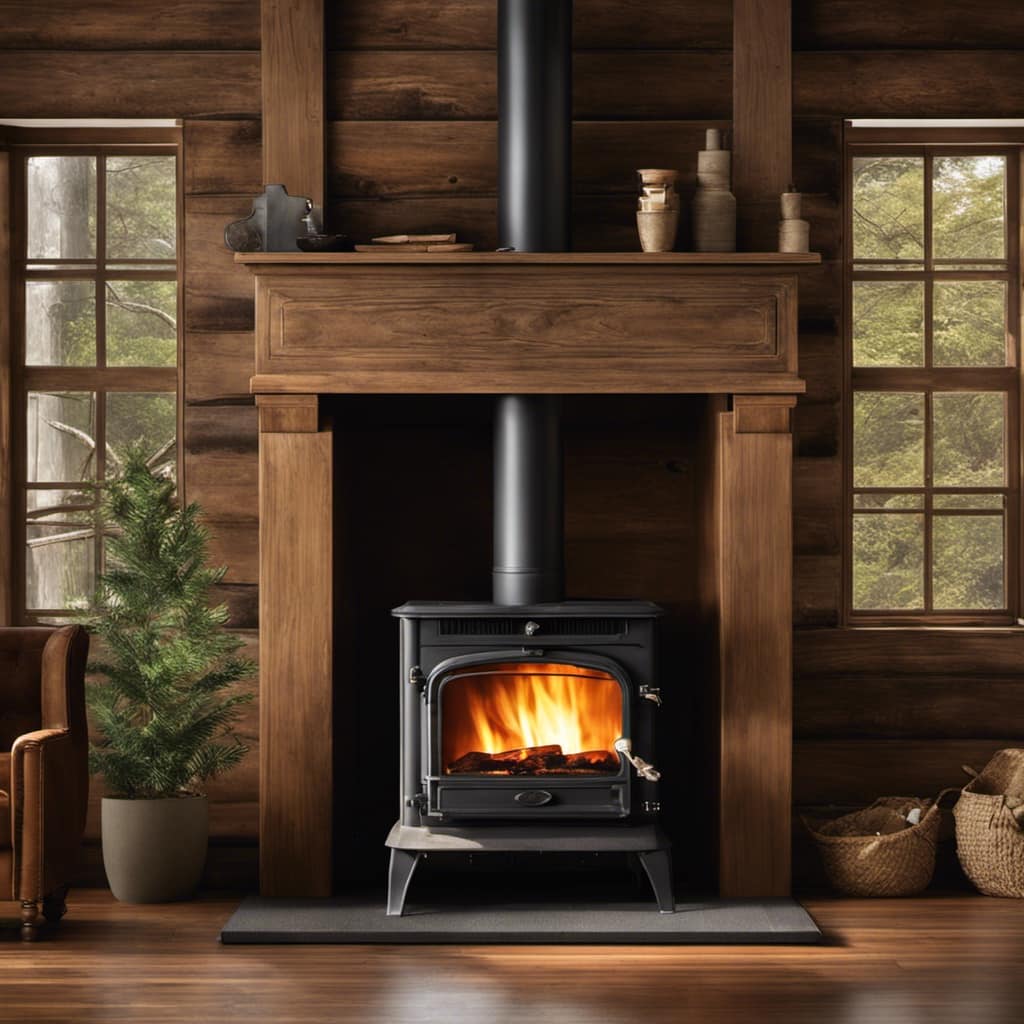
It’s crucial to follow local building codes and manufacturer guidelines. By taking these necessary precautions, you can enjoy the warmth of a wood stove in your garage without compromising safety.
What Are the Key Factors to Consider When Choosing the Right Wood Stove for My Garage?
When choosing the right wood stove for my garage, wood stove efficiency and proper ventilation are key factors to consider. Efficiency is important for maximizing heat output and minimizing fuel consumption. Look for a stove with high efficiency ratings and features like secondary combustion.
Proper ventilation is crucial to ensure safe operation and prevent the buildup of harmful gases. Install a chimney or flue system that meets the necessary safety standards and provides adequate airflow.
Do I Need Any Specialized Tools or Materials for the Installation Process?
Installing a wood stove in your garage requires specialized tools and materials.
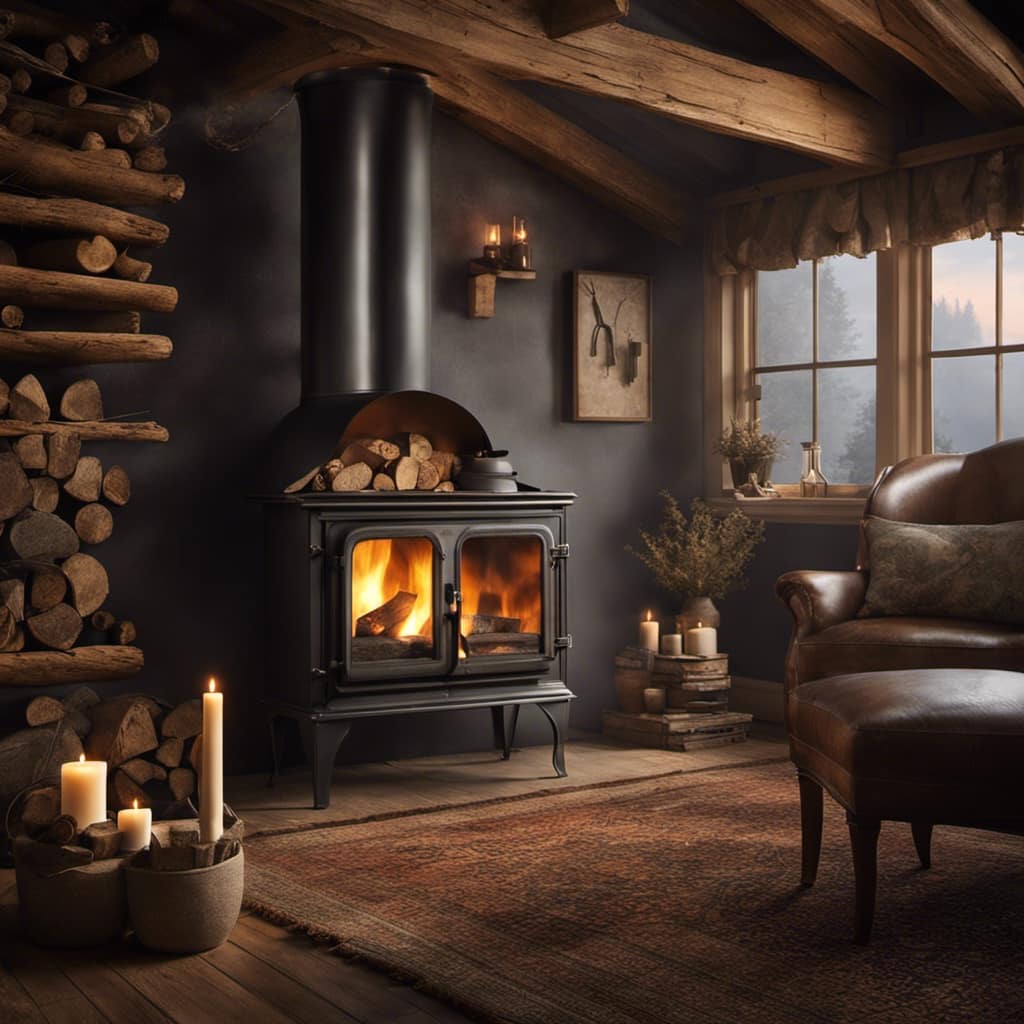
The first step is to gather the necessary tools, such as a drill, wrench, and level.
You’ll also need materials like chimney pipe, stove pipe, and fireproof insulation.
It’s important to carefully follow the manufacturer’s instructions for installation to ensure safety and efficiency.
With the right tools and materials, you can successfully install a wood stove in your garage and enjoy its warmth and functionality.
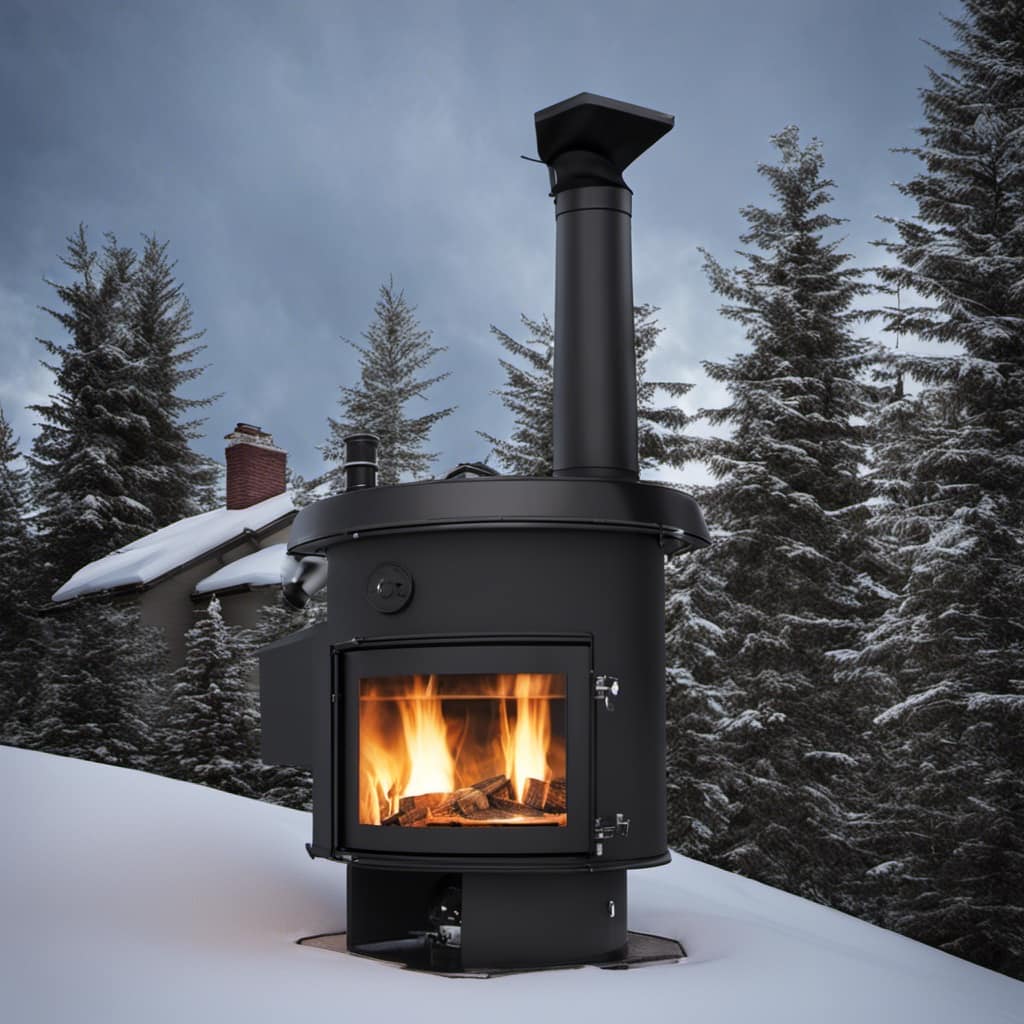
How Often Should I Clean and Maintain My Wood Stove to Ensure Its Longevity?
Cleaning frequency and maintenance tips are crucial for ensuring the longevity of your wood stove. Regular cleaning is necessary to remove ash and creosote buildup, which can reduce efficiency and increase the risk of fire. I recommend cleaning the stove and chimney at least once a year, or more frequently if you use it heavily.
Additionally, inspect the gaskets, door seals, and other components regularly for any signs of wear or damage, and replace them as needed.
Conclusion
Well, congratulations! You’ve successfully installed a wood stove in your garage.
Now you can enjoy the warm and cozy atmosphere while working on your projects.

Just make sure to follow the safety guidelines and maintain the stove regularly for optimal performance.
Who knew a garage could become the ultimate relaxation spot?
Keep those creative juices flowing and stay toasty!
Growing up surrounded by the vast beauty of nature, Sierra was always drawn to the call of the wild. While others sought the comfort of the familiar, she ventured out, embracing the unpredictable and finding stories in the heartbeat of nature.
At the epicenter of every remarkable venture lies a dynamic team—a fusion of diverse talents, visions, and passions. The essence of Best Small Wood Stoves is crafted and refined by such a trio: Sierra, Logan, and Terra. Their collective expertise has transformed the platform into a leading authority on small wood stoves, radiating warmth and knowledge in equal measure.




